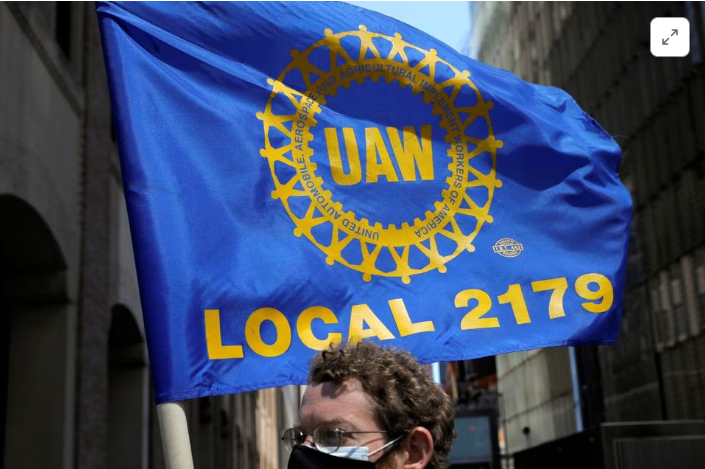
The UAW contracts at General Motors (GM.N), Ford Motor (F.N) and Chrysler parent Stellantis (STLAM.MI) expired at 11:59 p.m. EDT on Thursday.
Detroit automakers, like their global counterparts, have been focused on cost reductions, which in some cases include job cuts, to help accelerate a shift to electric vehicles (EVs) from gasoline-powered vehicles.
WHO IS THE UNION NEGOTIATING WITH?
The UAW, which represents 46,000 GM workers, 57,000 Ford employees and 43,000 Stellantis workers, kicked off negotiations with the companies in July.
The union historically has picked one of the Detroit Three to negotiate with first as the so-called target that sets the pattern on which subsequent deals are based. This time, UAW President Shawn Fain targeted all three companies simultaneously.
Contract talks between the UAW and the Detroit automakers in past years had gone on until the strike deadline and beyond.
WHAT ARE THE CURRENT OFFERS FROM THE DETROIT THREE?
Stellantis said on Saturday it has hiked its wage offer, proposing raises of 20% over a four-and-a-half-year contract term, including an immediate 10% hike. That matches proposals from GM and Ford.
The automakers say the proposals work out to a cumulative 21% hike over the period.
WHAT DOES THE UAW HAVE TO SAY ABOUT THE OFFERS?
The union previously has rejected the companies' offers. It has demanded a 40% wage hike, including a 20% immediate increase, and improvements in benefits.
"We'll organize one day longer than they can and go the distance to win economic and social justice at the Big Three," UAW President Shawn Fain said on Saturday.
WHAT ARE THE UNION'S DEMANDS?
The UAW is pushing automakers to eliminate the two-tier wage system under which new hires earn as much as 25% less than veterans.
Fain has said repeatedly that the union will push to restore pay improvements tied to the cost of living and retiree benefits cut during the 2008-2009 economic crisis.
The UAW also wants strong salary increases, given the financial success of the automakers, citing generous executive payouts and large U.S. federal subsidies for EV sales.
The union also wants defined benefit pensions for all workers restored, 32-hour work weeks and additional cost-of-living hikes, job security guarantees and an end to the use of temporary workers.
Fain also is aiming to get agreements that would allow the UAW to represent hourly workers at joint-venture EV battery plants opened or planned by the Detroit Three.
The UAW has been wary of the industry shift to EVs and called on the Biden administration to soften its proposed vehicle emission cuts that would require 67% of new vehicles to be electric by 2032.
EVs require fewer parts to build, and industry officials have said that will result in a need for fewer workers. Fain has said there should be no jobs lost because of the EV shift.
WHAT DO AUTOMAKERS WANT?
The Detroit Three want to close the cost gap they have with foreign automakers with non-unionized U.S. factories.
Ford sources estimate that their U.S. labor costs are $64 an hour, compared with an estimated $55 for foreign automakers and $45 to $50 for EV leader Tesla (TSLA.O).
The companies also want greater flexibility in how they use their U.S. workforces to increase efficiency and cut costs as the industry shifts to EVs.
WHAT IS AT STAKE?
The industrial action hit the Detroit Three automakers as they ramp up efforts to maximize gasoline and EV vehicle production to capitalize on demand for new vehicles.
A full strike would hit earnings at each affected automaker by about $400 million to $500 million per week assuming all production was lost, Deutsche Bank previously estimated. Some losses could be recouped by boosting production schedules later, but that possibility fades if a strike extends to weeks or months.
In fiscal 2019, GM's fourth-quarter profit took a $3.6 billion hit from a 40-day UAW strike.
A broad strike could also trickle down and squeeze quarterly profits for auto part suppliers such as Aptiv (APTV.N), Lear Corp (LEA.N) and Magna (MG.TO).
A 10-day strike by the UAW could cost manufacturers, workers, suppliers and dealers more than $5 billion, according to an analysis by the Anderson Economic Group, a consulting firm.
HOW WIDESPREAD IS THE STRIKE?
The walkout on Friday was smaller than some analysts expected, with only three auto plants in Michigan, Ohio and Missouri targeted. Those plants produce the Ford Bronco, Jeep Wrangler and Chevrolet Colorado, along with other popular models.